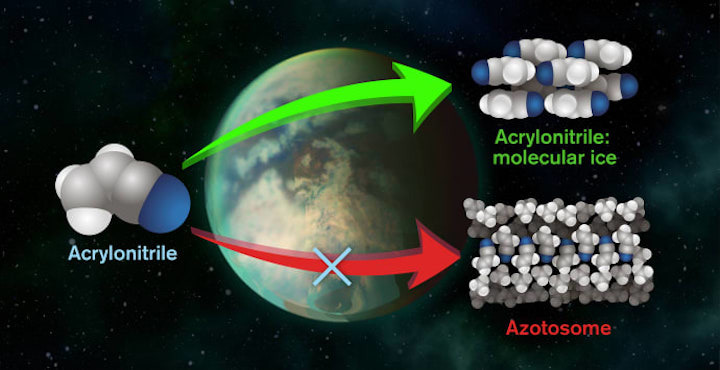3.03.2020

Researchers from Chalmers University of Technology, Sweden, have made a new contribution to the ongoing search into the possibility of life on Titan, Saturn’s largest moon. Using quantum mechanical calculations, they have shown that azotosomes, a proposed alternative form to conventional cell membranes, could not form under the conditions there. Their research is published in the journal Science Advances.
Titan, Saturn’s largest moon, has a dynamic surface, with seasonal rainfall, and lakes and seas at its polar regions, as well as a dense, nitrogen-rich atmosphere. These similarities to Earth have led many to consider the possibility of life there. The liquids on Titan are not water, however, but seas of methane and ethane, and the surface temperature is around –180C. Lipid membranes, of the type common to life on Earth, could not function under such conditions. This has led researchers looking for signs of life on Titan to contemplate alternative forms of cell membranes that could tolerate these extremes. One such alternative form, suggested by a team from Cornell University, is called an ‘azotosome’.
The idea of azotosomes has gained traction in the field of astrobiology, and it has been shown computationally that such structures would survive the conditions on Titan. The azotosome was proposed to be formed from the organic compound acrylonitrile – which was later confirmed to exist on Titan.
“Titan is a fascinating place to test our understanding of the limits of prebiotic chemistry – the chemistry that precedes life. What chemical, or possibly biological, structures might form, given enough time under such different conditions? The suggestion of azotosomes was a really interesting proposal for an alternative to cell membranes as we understand them,” says Martin Rahm, Assistant Professor at the Department of Chemistry and Chemical Engineering at Chalmers University of Technology.
“But our new research paper shows that, unfortunately, although the structure could indeed tolerate the extremes of Titan, it would not form in the first place,” he explains.
Using advanced quantum mechanical calculations, the researchers compared the energy of the proposed azotosome membrane embedded in methane with that of the molecular crystal form of acrylonitrile – its molecular ice. They discovered that each building block added to the azotosome increased its energy significantly, making its formation progressively less likely thermodynamically. They conclude therefore that while azotosomes could survive on Titan, they would not self-assemble under such conditions. Instead, acrylonitrile would crystallise into its molecular ice.
Despite the ‘negative’ results of their work, Martin Rahm sees the study, which was done together with PhD student Hilda Sandström, as providing highly valuable information for ongoing research in astrobiology.
“With this work we hope to contribute to the ongoing discussion on the limits of chemistry and biology in environmental extremes. Though we have shown that acrylonitrile is not a viable building block for workable cell membranes on Titan, we now have a better understanding of the environmental limits for cell membranes. Titan is a highly interesting and unique environment with many unanswered questions and possibilities left to explore,” he explains.
Their work is also an important step forward in demonstrating the potential of computational astrobiology, which offers the chance to evaluate, prior to experiments or sampling, whether or not a particular structure or process might be a biosignature, a marker for potential biology.
Interest in astrobiology on Titan is very high in the scientific community – so much so that in 2026, NASA will launch the billion-dollar Dragonfly spacecraft, which will make the 8-year journey to Titan to investigate its surface. It will spend around 3 years flying to different locations around the moon, assessing the conditions for habitability, prebiotic chemistry, and looking for signs of past and present life.
The likelihood of life on Titan and other similar worlds
While stressing that life under the extreme conditions found on Titan and other such worlds is highly unlikely, the researchers do, however, consider another possibility. They hypothesise that perhaps cell membranes are not a necessity for life everywhere, as we see they are on our Earth.
One crucial function of cell membranes on Earth is to protect the contents of a cell from being diluted and destroyed in larger bodies of liquid water. However, on the surface of Titan, any hypothetical life-bearing biomolecule would exist in the solid state, due to the low temperature, and never risk such destruction by dissolution.
Because hypothetical biomolecules on Titan would be immobile, they would need to rely on the diffusion of small energetic molecules, such as hydrogen gas or acetylene, to reach them before they could grow or replicate. Such molecules would need to be transported through the surrounding atmosphere or through liquid hydrocarbons, and a membrane would, in this case, hinder the desired diffusion. A membrane would likely be a similar obstacle in the opposite direction, for the necessary removal of waste products from the biomolecule’s metabolism.
“One can therefore ask what the benefit would be from having cell membranes under such different conditions?” explains Martin Rahm.
Quelle: Chalmers University of Technology
